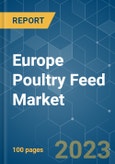Key Highlights
- Feed ingredients for poultry diets are selected for the nutrients they can provide, the absence of anti-nutritional or toxic factors, their palatability or effect on voluntary feed intake, and their cost. Currently, the demand for protein-rich feed is currently high in the EU, which will boost the market.
- The EU has lifted its ban on the use of animal by-products for animal feed which allows processed animal protein from pigs to be used in poultry feed and encourages the use of by-products from within the food industry, and also promotes the use of sustainable and local ingredients. The rules have to allow additional types of processed animal protein to be used in poultry and pig feed when they have been proven to be safe. The ban on the use of processed animal protein in feed for cows, sheep, and other ruminants, and on intra-species recycling, remains in force.
- According to the European Feed Manufacturers Federation (FEFAC), in 2021, even though there was severe Avian influenza in several parts of Europe, poultry feed production increased slightly by 0.8% because of HORECA chain (Hotel/Restaurant/ Catering) reopened after uplifting of lockdown.
- The major factors driving the market are the relatively low and competitive pricing of poultry meat compared to other meat, the absence of cultural or religious obstacles and dietary and nutritional (protein) qualities are the main factors of attraction driving the market growth. With the rising health crisis, consumers' attention has been mainly focused on production methods and the reliability of the information. The growing poultry production led to increased feed production in the region.
Europe Poultry Feed Market Trends
Growing Meat Production Drives the Market
Due to the rising meat consumption, producers are also shifting production trends to meet consumer demand. The European Union is one of the world’s largest poultry meat producers and a net exporter of poultry products with an annual production of around 13.4 million tons and imports high-value poultry products, including breast meat and poultry preparations, mainly from Brazil, Thailand, and Ukraine.As consumption in hotels, restaurants, and institutional (HRI) outlets resumes, demand for inexpensive chicken meat, especially from Brazil and Thailand, is rising. EU chicken meat imports now also benefit from the EU decision to temporarily suspend import quotas and tariffs on Ukrainian products. Within the EU, increasing food inflation and higher energy costs will continue to favor chicken meat consumption as other animal proteins remain relatively more expensive.
According to FAO, the production of poultry meat increased in Poland with 2.5 million metric tons last year, followed by France and Germany. The meat production in the region is projected to grow further during the forecast period, which will drive poultry feed production.
The Cereals Segment Dominates the Market
Cereal grains are used mainly to satisfy the energy requirement of poultry. The dominant feed grain is corn, although different grains are used in various countries and regions of the world. For instance, in the US, Brazil and most Asian countries corn is by far the most important energy source for all poultry feed, whereas wheat is the predominant supplier of dietary energy for poultry diets in Europe, Canada, Australia, New Zealand, and the Russian Federation. In addition to the cereals themselves, their by-products, such as wheat bran, rice bran, and DDGS, are used widely in poultry feed.Ukraine produces on average 26 million ton of wheat per year, most of which is exported. The FAO estimates that, due to the war, cereal production in Ukraine is likely to be reduced by between 20% and 30%. A more extreme scenario of a 50% reduction in Ukrainian wheat production which a deficit of 13 million ton of wheat and many lower-income countries outside the EU rely on food, is expected to be severely reduced due to the war. The main impacts of the war on EU farmers are a limited reduction in animal feed imports and a disruption in the supply chains of synthetic fertilizers, the majority of which is used to grow animal feed for industrial meat production.
According to FAOSTAT, Europe also imported cereals amounting to 90.6 million metric ton in 2021 compared to 93.8 million metric ton in 2020 which is slightly declined due to impact of pandemic in the region. Hence, the growing poultry population coupled with intensive production trends will further drive the growth of the segment during the forecast period.
Europe Poultry Feed Industry Overview
The European poultry feed market is fragmented, with the presence of various participants across several regions. The market studied displays unique characteristics, such as very few large manufacturing companies and a highly unorganized market with several regional players with small market shares. The leading companies are focused on acquiring feed mills and small manufacturing facilities to expand their businesses in the domestic and international markets. Terrena, Royal Agrifirm Group, Cargill Incorporated, De Hues, and Danish Agro are among the leading players in the market.Additional Benefits:
- The market estimate (ME) sheet in Excel format
- 3 months of analyst support
This product will be delivered within 2 business days.
Table of Contents
Companies Mentioned (Partial List)
A selection of companies mentioned in this report includes, but is not limited to:
- Alltech Inc.
- BASF SE
- Nutreco NV
- Cargill Inc.
- Terrena
- Danish Agro
- Royal Agrifirm Group
- De Hues
- Roquette Freres SA










